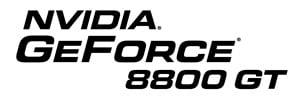
HOW WE CONFIGURED THE TEST SYSTEMS: We tested all of the graphics cards used in this article on either an EVGA nForce 680i SLI motherboard (NVIDIA GPUs) or an Asus P5E3 Deluxe (ATI GPUs) powered by a Core 2 Extreme QX6850 quad-core processor and 2GB of low-latency Corsair RAM. The first thing we did when configuring the test systems was enter their respective BIOSes and set all values to their "optimized" or "performance" default settings. Then we manually configured the memory timings and disabled any integrated peripherals that wouldn't be put to use. The hard drive was then formatted, and Windows Vista Ultimate was installed. When the installation was complete we fully updated the OS, and installed the latest DX10 redist and various hotfixes along with the necessary drivers and applications.
 |
|
The HotHardware Test System |
|
Core 2 Extreme Powered | |
|
Processor -
Motherboard -
Video Cards -
Memory -
Audio -
Hard Drive -
|
Hardware Used:
Core 2 Extreme QX6850 (3GHz)
EVGA nForce 680i SLI
nForce 680i SLI chipset
Asus P5E3 Deluxe
X38 Express
ASUS EN8800GT TOP
MSI NX8800GT
EVGA e-GeForce 8800 GT KO
GeForce 8800 GTS
GeForce 8600 GTS
Radeon HD 3870
Radeon HD 3850
Radeon HD 2900 XT
Radeon HD 2600 XT
2048MB Corsair PC2-6400C3
2 X 1GB
2048MB Corsair DDR3-1333 C7
2 X 1GB
Integrated on board
Western Digital "Raptor"
74GB - 10,000RPM - SATA
|
OS -
DirectX -
Video Drivers -
Synthetic (DX) -
DirectX -
DirectX -
DirectX -
DirectX -
OpenGL -
|
Relevant Software:
Windows Vista Ultimate
DirectX 10
NVIDIA Forceware v169.09
ATI Catalyst BETA v8.43
Benchmarks Used:
3DMark06 v1.0.2
Company of Heros - DX10
Crysis - DX10
Half Life 2: Episode 2*
Enemy Territory: Quake Wars*
* - Custom Test
(HH Exclusive demo) |
 |
| Performance Comparisons with 3DMark06 v1.0.2 |
| Details: www.futuremark.com/products/3dmark06 | |

3DMark06 |
3DMark06 is the most recent addition to the 3DMark franchise. This version differs from 3Dmark05 in a number of ways, and includes not only Shader Model 2.0 tests, but Shader Model 3.0 and HDR tests as well. Some of the assets from 3DMark05 have been re-used, but the scenes are now rendered with much more geometric detail and the shader complexity is vastly increased as well. Max shader length in 3DMark05 was 96 instructions, while 3DMark06 ups that number to 512. 3DMark06 also employs much more lighting and there is extensive use of soft shadows. With 3DMark06, Futuremark has also updated how the final score is tabulated. In this latest version of the benchmark, SM 2.0 and HDR / SM3.0 tests are weighted and the CPU score is factored into the final tally as well. |

Overall, the three GeForce 8800 GT cards we tested performed in-line with expectations in 3DMark06, considering each card's respective clock speeds. The Asus finished on top, followed by EVGA and then MSI. Also note, that the 8800 GTS 640MB card listed in the graphs is based on the G80, not G92. The newer G92-based version is faster than the 8800 GT.


If we tunnel deeper into 3DMark06's results, we see how each card's overall score was derived. Once again, as expected, the Asus card finished in the top spot in both the shader model 2.0 and shader model 3.0 / HDR tests, followed closely behind by EVGA's offering, and then the MSI NX8800GT.

![]()
![]()










